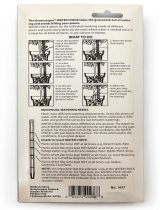Page is loading ...

Nymphaea Atttraction produces a
large red flower that becomes deeper in
color as the plant matures.
Nymphaea Fabiola produces pink
flowers that rest gracefully atop dark
green leaves.
Nymphaea Sioux’s unique flowers are
pale yellow on the first day and then
change to deep orange and finally
coppery red as the days progress.
Nymphaea Alba produces highly
fragrant bowl-shaped white flowers that
bloom June through August.
Nymphaea Chromatella cup-shaped
canary yellow flowers remain open
longer than those of most other
varieties.
Nymphaea Nero’s lightly fragrant,
peony-shaped flowers are very dark red
and nearly black at the center.
In US Hardiness Zones 3-11, hardy
water lilies can remain in the pond year
round. They will die off in the winter,
produce leaves in the spring, and
bloom during the summer months. As
long as the underground stem does not
freeze, the plants will come back and
grow to suit the size of the pond in
which they are planted.
GROWING INSTRUCTIONS
COMPLETE WATER PLANT
COLLECTION
Today’s water gardener proudly
points to the water plants in the pond
as much as to the aquatic wildlife.
Water lilies provide color and often a
delightful fragrance while marginal
plants help to blend the pond to the
surrounding landscape.
The Bloomsz “Complete Water Plant
Garden” provides 12 unique, easy to
grow plants to make a perfect water
garden.
WATER LILIES
Water lilies (Nymphaea) undoubtedly
comprise the largest number of
floating plants found in today’s
natural, commercial, and residential
ponds, water gardens, or landscape
water features. Considered by many
to be the jewels of the pond, they
spread vibrant color across the
surface of the water. The flowers are
in full bloom in mid-day and close
toward evening. New flowers blossom
constantly throughout the growing
season.
Water lilies also provide much needed
shade and shelter for fish and other
aquatic life, and absorb unwanted
nutrients from the water to prevent
algae blooms.
PLANTING INSTRUCTIONS: Water
lilies require sun to grow properly.
They begin to bloom when water
temperatures reach 60⁰ F, and will
bloom year round in frost-free
regions. Because they do not like
heavy water movement, place them
away from streams and waterfalls.
To make planting easy, our water
lilies come in a special drop and grow
net bag, each containing the rhizome,
rocks, and planting fiber. Simply
remove the net bag from the plastic
holding bag and drop it into a part of
the pond deep enough to be below
the ice line, if any. The depth of the
water should not be less than 2 feet
nor more than 4 feet. Fertilize in
spring and summer, removing yellow
leaves and spent flowers regularly.

BOG AND MARGINAL PLANTS
Bog and marginal water plants grow in
the shallow edges of ponds and
waterways. These plants are important
as they add texture and vertical accent
to the pond. Bog and marginal plants
cannot tolerate being submerged for
long periods of time, but they can
survive short dry spells.
Besides adding natural beauty and
being pleasing to the eye, bog and
marginal plants benefit ponds by
providing shade, controlling algae
growth, sheltering fish, and keeping the
water clean looking. They can also be
used to hide pond infrastructure. Grow
several different varieties together for
maximum effect, or use groups of the
same plant in various areas for a more
balanced design. Another idea is to
work with a single color or a single
color family.
PLANTING INSTRUCTIONS: Bog and
marginal water plants do best in
shallow water up to 6” deep and should
be planted after the spring chill has
subsided.
To make planting easy, our bog and
marginal plants come in a special drop
and grow net bag, each containing the
rhizome, and planting fiber. Simply
remove the net bag from the plastic
bag, place/plant the net bag at the
water’s edge, and cover it with the
pond’s soil.
In Zone 6 or warmer, the plants can be
left in place and not moved at all during
the winter months. Fertilize in spring
and summer, removing yellow leaves
and spent flowers regularly. Adding
good garden soil around the crowns
during fertilization will help to retain
fertilizer better and minimize leaching
into the water.
Acorus calamus variegatus has
narrow, bright green leaves with a
creamy white stripe running down the
center and grows about 18” tall.
Typha minima, also called “Mini
Cattails, grow 12-24” tall. The main
flowering period is May-June, but they
may also flower again in August.
Iris ensata grow 18-24” tall and are
beautiful both in and out of bloom.
Distinctively flattened blue flowers
perch atop sword-like green leaves.
Iris black Gamecock boasts dramatic
black to purple flowers and grows up to
36” tall.
Pontederia cordata grow 24-30” tall
and have either white or soft blue
flowers that bloom June-October.
Typha latifolia, or common cattail, is
the standard-size relative to Typha
minima and grows from 3-7’ tall.
Zantedeschia aethiopica, best-
known as Calla Lilies, boast pure white
flowers and grow 8-30” tall.
Zephyranthes candida, or Pink Fairy
Lilies, grow approximately 12” high and
boast delicate pink flowers amidst
evergreen foliage.
Bloomsz LLC
7450 Industrial Road
Florence, KY 41042
USA
/






